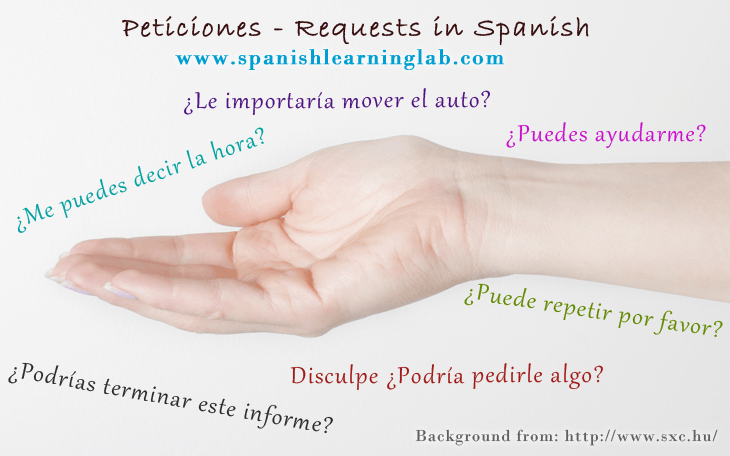Embark on a linguistic journey as we explore the intricacies of request in spanish language. From formal to informal settings, this guide will equip you with the essential phrases and cultural nuances to navigate the art of making polite and effective requests in Spanish-speaking environments.
Delving into the grammatical structure and usage of “request” in Spanish sentences, we’ll uncover the subtle differences between formal and informal language, empowering you to adapt your communication style to various contexts.
Definition of “Request” in Spanish
In Spanish, the word “request” is translated as “solicitud.” It is a noun that refers to an act of asking for something, typically in a formal or polite manner. The word “solicitud” can be used in a variety of contexts, including making a request for information, assistance, or permission.
Grammatically, the word “solicitud” is typically used as a direct object in a sentence. For example, you could say “Hice una solicitud de información” (I made a request for information). The word “solicitud” can also be used as the subject of a sentence, as in “La solicitud fue aprobada” (The request was approved).
Grammatical Usage
The word “solicitud” can be used in a variety of grammatical structures. Here are a few examples:
- As a direct object:Hice una solicitud de información (I made a request for information).
- As the subject of a sentence:La solicitud fue aprobada (The request was approved).
- In a prepositional phrase:Hice una solicitud por escrito (I made a request in writing).
Structure of “Request” in Spanish Sentences
The structure of a request in Spanish sentences can vary depending on the context. However, there are some general guidelines that you can follow.
- Use a polite form of address.When making a request, it is important to use a polite form of address. This can include using the formal “usted” (you) or the informal “tú” (you), depending on the situation.
- Be clear and concise.When making a request, it is important to be clear and concise. This means stating exactly what you want and avoiding any unnecessary details.
- Be respectful.When making a request, it is important to be respectful of the person you are asking. This means using polite language and avoiding any demands or ultimatums.
Formal and Informal Usage of “Request”
In Spanish, the word “request” can be expressed formally or informally, depending on the context and the relationship between the speaker and the listener.
Formal Usage
In formal settings, such as business letters or speeches, the following phrases are commonly used to make a request:
- Le agradecería que…
- ¿Podría usted por favor…?
- Solicito respetuosamente que…
Informal Usage
In informal settings, such as conversations with friends or family, the following phrases are more appropriate:
- ¿Puedes…?
- ¿Me podrías…?
- ¿Te importaría…?
Polite Expressions for Making Requests
Using polite language when making requests in Spanish is crucial for maintaining a respectful and positive tone. It demonstrates consideration for the person you’re addressing and increases the likelihood of your request being received favorably.
Common Polite Phrases and Expressions
- Por favor:Please
- ¿Podría por favor…?Could you please…?
- ¿Le importaría…?Would you mind…?
- ¿Sería posible…?Would it be possible…?
- ¿Tendría la amabilidad de…?Would you be so kind as to…?
Cultural Context of Requests

In Spanish-speaking cultures, the context of a request plays a significant role in determining the language used. The relationship between the speaker and listener, as well as the formality of the situation, can influence the choice of words and phrases.
Formal Requests
When making a formal request in Spanish, it is important to use polite and respectful language. The use of formal pronouns ( usted, ustedes) and the conditional tense ( condicional) is common. Additionally, it is customary to preface a request with a phrase such as “¿Podría por favor…?”(Could you please…?)
or “¿Sería posible…?”(Would it be possible…?).
- ¿Podría por favor pasarme la sal?(Could you please pass me the salt?)
- ¿Sería posible que me ayudara con este ejercicio?(Would it be possible for you to help me with this exercise?)
Informal Requests
In informal settings, Spanish speakers may use more casual language when making requests. The use of familiar pronouns ( tú, vosotros) and the imperative tense ( imperativo) is common. However, it is still important to be respectful of the person you are addressing.
- Pásame la sal, por favor.(Pass me the salt, please.)
- Ayúdame con este ejercicio.(Help me with this exercise.)
Common Errors in Making Requests

Making requests in Spanish can be tricky, and there are several common errors that learners should avoid to ensure their requests are polite and respectful.
One common mistake is using the imperative form of verbs without softening the request. The imperative form is typically used to give commands or instructions, and can come across as rude or demanding when used in a request. Instead, learners should use the subjunctive form of verbs, which is more polite and respectful.
Another common error is using the wrong verb tense. The present tense is typically used for requests that are made immediately, while the future tense is used for requests that will be made in the future. Using the wrong verb tense can lead to confusion or misunderstanding.
Finally, learners should be careful not to use too much slang or informal language in their requests. While it is acceptable to use informal language in certain situations, it is important to be aware of the context and to use formal language when necessary.
Using the Subjunctive Form of Verbs
The subjunctive form of verbs is used to express a variety of meanings, including requests, suggestions, and recommendations. When making a request, the subjunctive form of the verb should be used in the third person singular or plural, regardless of the number or person of the subject.
For example, to say “Can you open the window?” in Spanish, you would say ” ¿Puede abrir la ventana?” The verb ” abrir” is in the third person singular subjunctive form.
Using the Correct Verb Tense
The present tense is typically used for requests that are made immediately, while the future tense is used for requests that will be made in the future. Using the wrong verb tense can lead to confusion or misunderstanding.
For example, to say “Can you help me with this?” in Spanish, you would say ” ¿Puede ayudarme con esto?” The verb ” ayudar” is in the present tense, indicating that the request is being made immediately.
Avoiding Slang and Informal Language
While it is acceptable to use informal language in certain situations, it is important to be aware of the context and to use formal language when necessary. Using slang or informal language in a request can come across as disrespectful or unprofessional.
For example, to say “Can you give me a hand?” in Spanish, you would say ” ¿Puede echarme una mano?” The phrase ” echar una mano” is a formal way to ask for help, while the phrase ” dar una mano” is more informal.
Advanced Usage of “Request”
The Spanish language offers a rich repertoire of grammatical constructions and idiomatic expressions that can enhance the precision and effectiveness of requests. By mastering these advanced techniques, you can communicate your needs and desires with greater clarity and sophistication.
Idiomatic Expressions
Spanish is replete with idiomatic expressions related to requests. These expressions often convey a specific tone or nuance that cannot be easily expressed through literal translations. For instance:
- Te agradecería que…(I would appreciate it if…)
- ¿Podrías por favor…?(Could you please…?)
- Me vendría bien si…(It would be helpful if…)
These expressions help soften the request and convey a sense of politeness and respect.
Conditional Sentences, Request in spanish language
Conditional sentences are another valuable tool for making requests. By using the conditional tense, you can express a request in a more indirect and tentative manner. For example:
Si pudieras ayudarme, te lo agradecería mucho.(If you could help me, I would greatly appreciate it.)
This sentence conveys a sense of politeness and suggests that the speaker is not making an outright demand.
Subjunctive Mood
The subjunctive mood is commonly used in Spanish to express requests or suggestions. The subjunctive mood creates a sense of uncertainty or possibility, which can be appropriate in certain contexts. For example:
Quisiera que me ayudaras con esto.(I would like you to help me with this.)
This sentence uses the subjunctive mood to express a polite request without sounding overly assertive.
Translation Techniques for Requests: Request In Spanish Language

Translating requests from Spanish to English and vice versa presents unique challenges due to cultural and linguistic differences. To ensure effective communication, it’s crucial to consider the tone, formality, and cultural context of the request.
When translating requests from Spanish to English, it’s important to maintain the original tone and formality. In Spanish, requests are often made using polite and indirect language, while in English, they can be more direct. Translators should strive to convey the intended level of politeness and respect in the target language.
Tips for Translating Requests
- Use appropriate tone and formality:Match the tone and formality of the original request in the target language.
- Consider cultural context:Be aware of cultural differences in making requests and adapt the translation accordingly.
- Convey politeness:Use polite phrases and expressions to maintain a respectful tone in the target language.
- Avoid direct translations:Literal translations may not always convey the intended meaning or tone of the request.
- Seek feedback:Get feedback from native speakers of the target language to ensure the translation is accurate and appropriate.
Ultimate Conclusion
Mastering the art of request in spanish language not only enhances your linguistic abilities but also fosters cultural sensitivity and respect. By understanding the nuances of polite language, cultural etiquette, and advanced grammatical constructions, you’ll elevate your communication skills and build stronger relationships in Spanish-speaking communities.
FAQ Resource
How do I make a formal request in Spanish?
Formal requests typically begin with polite phrases like “Le agradecería mucho si pudiera…” or “Me gustaría solicitar…” followed by the specific request.
What are some common mistakes to avoid when making requests in Spanish?
Avoid using overly direct or demanding language, and be mindful of the cultural context and relationship between the speaker and listener.
How can I translate requests from Spanish to English effectively?
Pay attention to the tone, formality, and cultural context of the request to ensure an accurate and appropriate translation.